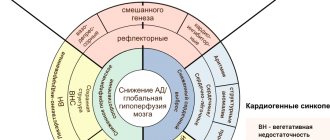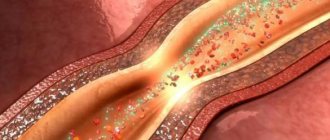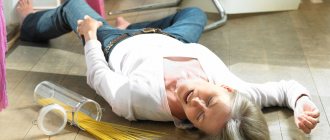Cramps are involuntary muscle contractions that cause spasms. Such manifestations occur suddenly, do not last long, and may recur periodically. They often cause severe pain, especially in the elderly and children. Most often, cramps appear in the lower extremities, thigh muscles, and calves. The neck, back, hands, and abdomen are susceptible to these painful manifestations. Spasms of internal organs are quite rare. With regular repetitions, convulsive syndrome is diagnosed.
Types of seizures
All categories of people can experience seizures, regardless of age and lifestyle; they appear more often in the elderly and young children. Attacks are manifested by unequal painful muscle contractions and have different durations, mechanisms of development and frequency of occurrence. They are classified according to several criteria.
By locality
Depending on whether one muscle or a group of them is seized by a spasm, spasms are divided into:
- unilateral – when pain occurs on one side;
- focal (local) - appear in one muscle group;
- generalized - affect the whole body, causing involuntary urination, loss of consciousness and even respiratory arrest.
By duration of exposure
Classified into:
- myoclonic - short-term contractions or twitches, mainly in the upper part of the body, stop quickly and do not cause pain;
- clonic - characterized by a longer duration, muscles contract rhythmically, can be of a local or general type, sometimes contribute to stuttering;
- tonic – long-term, can occur in any part of the body, affect the respiratory tract, the part of the body seized by a convulsion takes one forced position, can lead to loss of consciousness;
- tonic-clonic - in which tonic spasms turn into clonic; if the second type predominates, they are called clono-tonic.
Classification
According to the mechanism of formation, convulsions are classified as rapid hyperkinesis, in the structure of which the phasic component predominates. They are divided into epileptic and non-epileptic, primary (idiopathic) and symptomatic (secondary). Depending on the nature of the predominant involvement of skeletal muscles, there are several types of convulsive contractions:
- Tonic
. Sharp and prolonged (up to several tens of seconds) muscle tension caused by the arrival of a nerve impulse of long duration. Leads to “freezing” of the limbs or body in a forced position. - Clonic
. Muscle spasms are short-term and irregular in nature, with rapid alternation of periods of contraction and relaxation. They have a locomotor effect, accompanied by motor acts. - Mixed
. Convulsive attacks characterized by a change from a tonic component to a clonic one or vice versa are called mixed. In most cases they are generalized (widespread) in nature.
Tonic spasms underlie athetosis; a type of clonic spasms is myoclonus - sudden and sharp (lasting up to a second) contractions of the flexor muscles. Based on the group of muscles affected, cramps can be flexor (flexor), extensor (extensor), or mixed. An important criterion that has found a place in the clinical classification is the prevalence of seizures, which allows us to distinguish two types of paroxysms:
- Partial (focal)
. They arise due to local activity involving a group of motor neurons. Accompanied by clonic or tonic contractions. They can be simple (without loss of consciousness), complex, secondary generalized. - Generalized
. Excitation immediately covers the entire cortex without the presence of an isolated focus, so the muscles of the entire body are involved in a seizure. Paroxysms are clonic, tonic, tonic-clonic. Myoclonic and atonic seizures are also distinguished.
Some conditions combine signs of focal and generalized paroxysms or are of an unspecified nature. In pediatric practice, afebrile and febrile convulsions, neonatal and infantile paroxysms are distinguished. The international classification for some seizures takes into account the prognosis (benign, severe).
Causes of seizures
There are several factors that influence the occurrence of seizures.
Occupational activities - People whose jobs involve standing in a single position all the time (salespeople, computer operators, etc.) or who are exposed to repetitive physical stress experience cramps at night or in the evening. People who smoke experience muscle cramps 5 times more often; the leading causes of cramps are smoking or extremely frequent drinking of coffee.
Often night cramps appear after a day spent in constant movement or even an ordinary brisk walk - this becomes the cause of calf cramps. The same result causes unusual significant physical stress. It should be taken into account in advance that it is undesirable to strain one muscle group; physical work should alternate with periodic rest.
Night cramps are much more common because the posture of the sleeping person contributes to this: relaxed and downward-facing feet, bent legs and the body turned on its side. This position shortens the calf muscle and helps cause spasms. Night leg cramps occur in athletes after significant daytime stress, children (especially with fever) and the elderly due to circulatory disorders in the extremities.
Severe cramps are not uncommon when swimming in cool water on a hot day. Temperature changes can also cause spasms in the pool: heated muscles contract sharply with sudden changes in the environment.
Cramps also appear as a result of severe dehydration, especially in those who engage in sports training or heavy physical labor in the hot season.
Stressful conditions can cause convulsions, and the effect does not occur immediately, but after a while, when calcium is redistributed in the body due to an excess of the hormone cortisol.
Spasms of the fibers of the foot muscles can appear as a result of wearing tight shoes or high loads with flat feet.
Another reason that leads to cramps in the arms and legs is the uncontrolled use of statins, dauretics, antibiotics and other drugs that redistribute or remove microelements from the body. Drug treatment of seizures is carried out with mandatory monitoring of the biochemical composition of the blood.
Treatment of seizures
Help before diagnosis
Regardless of the cause, seizures are an acute condition that requires qualified medical care. Local painful spasms can be eliminated by self-massage, pinching, or stretching the muscle. When a generalized attack develops, it is important to provide first aid to the victim: place a cushion or pillow under the head, turning it on its side, clear the mouth of foam and mucus, and provide access to fresh air. The ambulance team stops the paroxysm with anticonvulsants; in case of high fever in children, antipyretics are administered.
Conservative therapy
Hospitalization is necessary for everyone who has developed a seizure for the first time, with severe and prolonged paroxysms, or with the presence of aggravating pathology. After verification of the diagnosis, along with symptomatic correction, treatment of seizures involves eliminating the causes and influencing the main pathogenetic moments of their development. Based on the clinical situation, the following groups of medications can be used to relieve attacks and treat the underlying disease:
- Anticonvulsants
. Treatment of partial and generalized epileptic seizures is carried out with lamotrigine, carbamazepine - in monotherapy or in combination with other drugs. Convulsive syndrome in organic pathology of the central nervous system can be treated with valproate, clonazepam; in the neonatal period, the drugs of choice are phenobarbital and diphenine. Refractory epistatus requires the administration of anesthesia (sodium thiopental, propofol). - Electrolytes
. Relief of spasmophilia and hyperkalemia is carried out with calcium preparations. Chloroprivate tetany and hyponatremia are treated with sodium chloride infusions; hypomagnesemia is corrected with magnesium sulfate. To eliminate metabolic alkalosis, saline solution and potassium chloride are used. - Hypotensive
. To correct blood pressure during eclampsia, including renal eclampsia, and hypertensive crises, peripheral vasodilators (sodium nitroprusside), beta blockers (esmolol), and ganglion blockers (pentamine, arfonade) are used. Diuretics - osmotic (mannitol, urea), loop (furosemide) - help eliminate concomitant cerebral edema.
In case of poisoning, antidote, detoxification, and infusion therapy are carried out; withdrawal forms of epistatus are treated with a combination of anticonvulsants and antipsychotics. Detection of neuroinfections requires appropriate antimicrobial (antibacterial, antiviral) correction; hypoglycemia is treated with glucose, pyridoxine-dependent seizures with vitamin B6. In some cases, a high-fat ketogenic diet is recommended to relieve seizure symptoms.
Surgery
Drug-resistant variants of epilepsy are an indication for more radical treatment. Among neurosurgical interventions, resections (temporal and extratemporal, hemispherectomy), disconnection operations (subpial transsections, callosotomy), and transcranial stimulating methods are practiced. As a result, it is possible to achieve a complete cessation of attacks within a year or a significant reduction in their frequency with the achievement of adequate control.
Some symptomatic seizures are also treated surgically. In case of traumatic brain injuries and strokes, early intervention is necessary, aimed at evacuation of intracranial hematoma and decompression of cerebral structures. Abscesses and brain tumors also need to be removed. Intravascular recanalization operations - intraarterial thrombolysis, thrombectomy, angioplasty with stenting - are designed to restore blood flow in ischemic areas of brain tissue.
Diseases and consequences
In addition to circumstances related to lifestyle or specific events, the muscular system may be subject to cramps due to the presence of a specific disease, to identify which it is necessary to seek help from medical institutions for examinations, tests and treatment.
Spasms can be symptoms of unrelated diseases. We can say that leg and arm cramps differ from spasms that occur in smooth muscle fibers and cause pain inside the body, which most often indicate diseases that require regular treatment.
If we characterize the main diseases leading to seizures, their list will look like this:
- epilepsy and concomitant epileptic seizures cannot do without muscle cramps;
- opisthotonus, better known as tetanus, is necessarily accompanied by severe spasms;
- there is such a thing as psychogenic convulsions, characteristic of hysterical neuroses and other neurotic conditions;
- inorganic and organic poisons also cause involuntary contractions of muscle tissue;
- The most common factor leading to severe muscle tension is an excess or deficiency of microelements such as magnesium, potassium and others.
Improper distribution of microelements is caused by various reasons. Failure of the endocrine system requires serious treatment prescribed by a doctor, and metabolic disorders caused by other reasons can be corrected with medications.
Why do seizures occur?
Causes of tonic seizures
Prolonged muscle tension occurs against the background of excessive excitability of cerebral structures, in conditions of disruption of the cortical regulation of segmental functions. Very often, neurons are negatively affected by toxic, metabolic factors, and endocrine and metabolic disorders. The causes of tonic seizures are the following conditions:
- Infections
: tetanus, rabies, febrile syndrome. - Electrolyte disturbances
: hypocalcemia, hyperkalemia, hypomagnesemia. - Endocrine disorders
: hyper- and hypoglycemia, hyperinsulinism. - Hereditary metabolic diseases
: amino acid (leucinosis, phenylketonuria), carbohydrate (glycogenosis, galactosemia), lipid (Gaucher disease, Norman-Wood disease). - Cardiovascular pathology
: complete atrioventricular block, acute hypotension. - Renal and liver failure
: uremia, bilirubin encephalopathy. - Psychogenic disorders
: hyperventilation syndrome, hysteria. - Epileptic syndromes of childhood
: Lennox-Gastaut encephalopathy, Otahara encephalopathy, infantile spasms. - Intoxication
: alcohol, carbon monoxide poisoning, strychnine. - Overdose of drugs
: morphine, antipsychotics. - The effect of physical factors
: severe overheating or hypothermia, electrical injuries, the influence of radiation.
Sometimes painful spasms are of a professional nature, occurring during prolonged muscle tension in stenographers, musicians, and milkmaids. Leg cramps are common among athletes and people whose work involves standing for long periods of time. They are often observed during pregnancy, with vascular pathology of the lower extremities - varicose veins, obliterating atherosclerosis, endarteritis.
Causes of clonic seizures
Pathological impulses that provoke short-term spasms of skeletal muscles are formed in higher cortical centers, the extrapyramidal system or peripheral motor neurons. Some clonic seizures develop due to focal damage to the brain stem or spinal cord due to tumors and strokes. Other causes of such seizures include:
- Focal epileptic seizures
. - Children's infections
: measles, chickenpox, influenza, parainfluenza. - Severe myoclonic epilepsy of infancy (Dravet syndrome)
. - Diffuse damage to gray matter
: Creutzfeldt-Jakob disease, subacute sclerosing panencephalitis. - Neurodegenerative conditions
: Tay-Sachs, Alpers diseases. - Non-progressive encephalopathies
: with Down syndrome, tuberous sclerosis. - Neonatal paroxysms
: “fifth day seizures”, benign familial epilepsy. - Poisoning
: drugs (piperazine, ergotamine), chemicals (formaldehyde, arsenic).
Causes of tonic-clonic seizures
Often in the clinical picture there is a change from tonic convulsive contractions to clonic ones. Generalized mixed seizures are a typical sign of epilepsy and its severe complication - epistatus. The occurrence of paroxysmal electrical activity of brain neurons is caused by a wide range of damaging factors:
- Cerebral pathology
: vascular disorders (CVA, arteriovenous malformations, aneurysms), traumatic brain injuries, tumors. - Infectious diseases
: polio, cholera, neuroinfections (meningitis, encephalitis, abscesses). - Arterial hypertension
: renal eclampsia, convulsive form of hypertensive crisis. - Toxicoses of pregnancy
: eclampsia. - Hereditary pathology
: leukodystrophy. - Intoxication
: nicotinic, narcotic (amphetamine, cocaine), poisoning (organophosphorus compounds, oxalic acid, lead). - Overdose of medications
: caffeine, atropine, amitriptyline, etc.
What to do if you have seizures
Muscle contractions that are not associated with serious illness do not require specialized treatment, but the pain they cause does need to be addressed. Therefore, there are simple methods that have proven their effectiveness:
- massaging or shocking frozen muscles;
- elimination of spasm with an injection of a regular needle;
- massage stiff calf muscles - pull your big toes towards you;
- the same group of muscles relaxes with the help of standing stretches - with your hands, reach the fingers of the sore limb resting on the floor surface;
- when the muscles of the front surface of the thighs spasm, the knee bends, and the foot is pulled from behind towards the buttocks.
These methods allow you to get rid of the pain that has arisen, but if it appears quite often, the treatment of seizures should begin with identifying the causes that cause them and prevention.
What are the causes of leg cramps at night with varicose veins?
There may be several of them. The root cause of cramps in varicose veins is stagnation of blood in the veins, which is inevitable with this disease. The blood stagnates, the pressure in the veins increases, and water leaks into the surrounding tissues. But along with it comes microelements that are needed for normal muscle contraction - potassium, calcium and sodium. As a result, the muscles begin to contract spontaneously, and these are cramps. It is impossible to get rid of this at home: varicose veins can only be cured by a doctor. That is why, if you are bothered by leg cramps at night, we recommend that you consult a phlebologist.
Secondly, with varicose veins, blood flow in the veins is difficult, and at night it becomes especially slow. Muscles may begin to contract in impulses to “push” blood through the vessels.
Photo: freepik.com
And thirdly, there is another, slightly more complex mechanism. The point is not only that the muscle contracts, but also that it does not relax. Muscle relaxation is also an energy-consuming process, so it requires ATP molecules, the universal “fuel” of a living cell. When blood stagnates in the veins, ATP production decreases and the mechanism that “relaxes” the muscle fails.
Magnesium and potassium
Cramps that periodically appear in the feet, legs, and fingers can occur in people who consider themselves to be completely healthy. Treatment of this unpleasant and painful sensation must begin with a review of the lifestyle and nutritional composition.
It is necessary to understand whether there is enough magnesium and potassium in the diet, the lack of which can not only lead to seizures, but also make them permanent. It is these microelements that regulate the functioning of muscle fibers. Hypomagnesemia causes cramps in the legs, arms, back, neck, and tingling of the fingertips. Treatment with drugs for seizures can relieve pain.
How to get rid of night leg cramps?
If you wake up at night from a sudden cramp, then the first desire is to rub your sore leg. Unfortunately, this does not always help relieve pain.
Lying down, you can do the following: pull the foot of the sore leg towards you, while simultaneously squeezing and unclenching the calf muscle with your palms (after all, it is usually the one that cramps). This will help to quickly relieve the attack. After this, work with the feet of both legs, make circular movements or alternately pull them towards you. This will activate blood circulation and the pain will go away.
Some people advise that if a cramp is very intense, try to relieve it by pricking your leg with a pin or needle. We doubt you'll have it handy while you sleep at night. But you can pinch yourself on the shin several times, although this can be difficult if the cramp is very strong.
Photo: sunlight19 / freepik.com
Also, if your leg cramps, you can stand on a bare, cool floor (but not on the carpet, the effect will not be the same) and try to walk. And when the muscle relaxes, still standing on the floor, shift from toe to heel for a minute. This simple exercise will help improve blood circulation.
How to prevent seizures
Measures aimed at eliminating and preventing the occurrence of seizures should include:
- giving up harmful addictions (smoking, excessive consumption of alcohol, coffee, tonic drinks); — sufficient daily fluid intake; — physical education to improve blood circulation; - enriching the body with vitamins and microelements (deficiencies in specific compounds can be identified using tests); - Night cramps can be prevented by a warm bath or shower.
To treat and prevent seizures, purchase a complex containing magnesium as a therapeutic measure. Even if there is no deficiency of this mineral in the body, it acts as an anticonvulsant element that reduces neuromuscular excitability.
Preventing seizures
- If you feel overtrained, then it may be worth reducing the intensity of your exercise for a while.
- Another solution is to take a hot bath before bed. Hot water helps muscles relax, which reduces the risk of cramps. Adding Epsom salt will help enhance the positive effect of this procedure.
- The cold makes your muscles tense, so make sure that you are warm at night, otherwise, “in your sweet dreams,” you can “meet” cramps again.
- Consume sufficient minerals from food.
- Replenishing mineral deficiencies from nutritional supplements.
Magvit is an excellent cure for seizures
One of the most affordable, safe and effective medicines for treating seizures is the drug “Magvit” , produced by the Belarusian pharmaceutical company “Minskintercaps”.
This is the first drug completely developed by domestic pharmacists and has a beneficial effect in the treatment of seizures.
“Magvit” successfully fights both primary and secondary magnesium deficiency, and the pyridoxine (vitamin B6) included in the drug improves the absorption of magnesium into the blood and its absorption at the cellular level.
The combined use of vitamin and magnesium citrate components of the drug is justified by the following clinically proven data:
- magnesium and B6 enhance and complement the pharmacological effects; — the vitamin helps reduce the amount of magnesium excreted from the body and increases its content in red blood cells; - absorption and assimilation of magnesium improves; - Pridoxine, under the influence of magnesium in the human liver, transforms into the active metabolite pyridoxal-5-phosphate.
First aid for muscle cramps in everyday life, in the water
Contracts muscles throughout the body (the reasons do not affect the method of providing first aid) in people when they are both in water and during everyday activities.
The article discusses the main causes and methods of treating cramps, which cause cramping of muscles throughout the body.
To minimize pain during cramps, you must:
- Sit on a hill and lower your legs down, relaxing the muscles of the lower extremities as much as possible.
- If there is no result from step 1: stretch the limb into an unnatural position for it, for example, pull the foot towards you or make several rotational movements.
- Prick the site of spasm with a needle.
If at the moment of spasm a person is in the water, he should take his cramped leg with his hands, bend it at the knee and pull the foot towards his stomach.
Advantages of Minskintercaps drugs
The company has earned well-deserved fame thanks to the production of inexpensive, high-quality medicines. All drugs comply with the requirements of the GMP standard, and their quality and composition are tested in a chemical and biological laboratory accredited in accordance with the requirements of STB ISO/IEC 17025.
The drugs are created from raw materials supplied by the world's leading companies; production is controlled by Pharmacovigilance and meets the requirements set by the European Parliament.
13 Feb 2018
Previous News Feed Next
What to do if your muscles cramp frequently, for a long time, constantly?
Frequent seizures not only reduce a person’s quality of life, but can also intensify in the absence of measures to eliminate the cause of their formation. The danger of prolonged muscle contraction lies in disturbances in blood circulation during this period, which can lead to pathologies of the vital systems of the body (for example, the development of varicose veins or thrombosis of the extremities).
If muscles throughout the body cramp more than once a month, you should consult a therapist. The doctor, having collected the necessary information, will independently prescribe treatment or refer the patient to a specialist.
Causes
The functioning of the brain is a complex process that requires the constant interaction of many structures. A failure at any level can cause the formation of an epileptogenic focus. Among the most common causes of epilepsy in adults and children are:
- heredity;
- traumatic brain injuries;
- acute or chronic intoxication, especially alcoholism;
- infectious lesions of the brain or its membranes (encephalitis, meningitis);
- acute and chronic cerebrovascular accidents, including strokes;
- malignant and benign tumors in the cranial cavity;
- birth injuries;
- parasites that develop in brain structures: echinococcus, pork tapeworm;
- neurodegenerative diseases (Alzheimer's disease, multiple sclerosis, Pick's disease);
- hormonal imbalances, especially lack of testosterone;
- metabolic disorders, etc.
There are cases when the cause of epilepsy cannot be identified. In this case, the disease is called idiopathic.
How to treat seizures
If cramps cause you discomfort (wake you up at night or last for quite a long time, despite massage and compresses), go to a therapist. To identify problems with your body, your doctor will ask you several questions. For example:
- How often do you have cramps?
- What muscles do they affect?
- Are you taking any medications?
- How often do you drink alcohol?
- What is your lifestyle and physical activity like?
- How much fluid do you drink daily?
Blood and urine tests may be required for a more complete diagnosis. With their help, the doctor will find out the level of microelements and will also be able to check the condition of the kidneys and thyroid gland. In some cases, electromyography is prescribed. This is a test that measures muscle activity and diagnoses existing muscle disorders.
As a result, the doctor will determine the disease, the symptom of which is seizures, and prescribe specific treatment.
How to prevent seizures
Considering the most common causes of muscle spasms, prevention is obvious:
- Drink more water to stay hydrated.
- Don't abuse alcohol. Among other things, it is a powerful diuretic and provokes fluid loss.
- Warm up regularly to prevent circulatory problems.
- Wear comfortable shoes.
- Try to avoid stress and nervous tension. You should have proper rest and sleep.
- Make sure your diet is complete and includes foods rich in potassium, magnesium and calcium: fermented milk, cereals, leafy greens, nuts, and so on.
- If necessary, take mineral complexes and dietary supplements. Naturally, do this after consulting a therapist.









